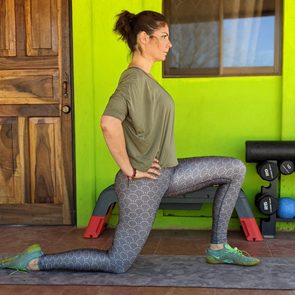Protect Your Groin With 4 Easy Stretches
Updated: May 28, 2021
You rely on your groin muscles all day, every day. Prevent injuries, ease aches, and improve flexibility in your adductor muscles with these simple groin stretches.
The importance of groin stretches
If you’ve ever “pulled your groin,” you know exactly how much pain these often-overlooked muscles can cause.
The reality is, even though you use your groin muscles as you move around throughout the day, unless you spend a lot of time playing sports that require quick, side-to-side movements, you probably don’t give them a second thought.
But the groin (which is actually made up of five separate muscles) is critical for actions as simple as side-stepping through a crowded room or swinging your leg up onto the bed as you’re laying down.
And because of its critical importance in day-to-day life, maintaining flexibility at your inner thigh is also equally important. Making groin stretches part of your regular routine will keep you moving—minus aches and pains—through your daily activities.
Here’s everything you need to know about stretching out your groin.
(Loosen your hips with the frog stretch.)
What groin muscles do for you
You’re probably aware that the “groin muscles” can be found high up on your inner thigh, close to your crotch. But if your knowledge ends there, you’re not alone.
These smaller leg muscles don’t get the press that the quads, glutes, or hamstrings receive, but that doesn’t make them any less important.
“There are five muscles that make up the groin region—the adductor complex, which includes the adductor magnus, brevis, and longus, as well as the gracilis and pectineus,” explains Alissa Tucker, a certified personal trainer and master trainer at AKT, a dance-based workout studio.
“These muscles are responsible for adduction of the leg, or bringing the leg back to center,” she says.
Think about an “anatomically neutral” body position, with your legs aligned directly under your hips. Whenever one of your legs is positioned farther away from this midline, the groin muscles are responsible for pulling it back to center, or even across the centerline to the opposite side of your body.
For instance, if you’re a soccer player who has to maneuver around a defender with the soccer ball, you’re regularly putting your groin to use.
Likewise, activities like tennis, pickleball, doing jumping jacks, or inline skating also require strong and flexible adductors.
(What you need to know about adduction vs. abduction.)
Groin injuries can happen to anyone
Unfortunately, the groin is often overlooked in training programs, which means the adductors are often weak and inflexible compared to the surrounding musculature. This combination can be a recipe for injury.
“Groin injuries are common in athletes and typically occur from sudden changes in direction, side-to-side movements, and kicking and twisting,” Tucker explains.
But even if you don’t consider yourself an athlete, don’t assume you’re free-and-clear.
Anyone with weak, tight adductors can end up with a lot of pain through the thigh and crotch if your body isn’t prepared to respond to day-to-day changes in direction, side-to-side movements, or kicking or twisting. And chances are, you do a few of those actions on a regular basis.
(Try a well-rounded lower-body workout routine with these leg exercises.)
Groin stretches for better flexibility
The first step to preventing injuries is awareness.
In your workout program, do you include a lot of forward-backward motions, like running, cycling, squatting, and lunging? If you do, chances are they lack side-to-side motions (like side lunges, side slides). If so, it’s time to add some balance to your routine.
But in addition to strength training your adductors and abductors, you also need to make sure you’re spending time stretching them out.
According to Tucker, these are the moves you should add to your post-workout routine when your body is nice and warm.
(These are the dynamic stretches you should do before your workout.)
Lateral lunge
The lateral lunge, when used as a stretch, is an excellent way to target your groin.
Remember to move slowly and consciously, coming to the point of stretch without forcing or pushing yourself into a deeper lunge.
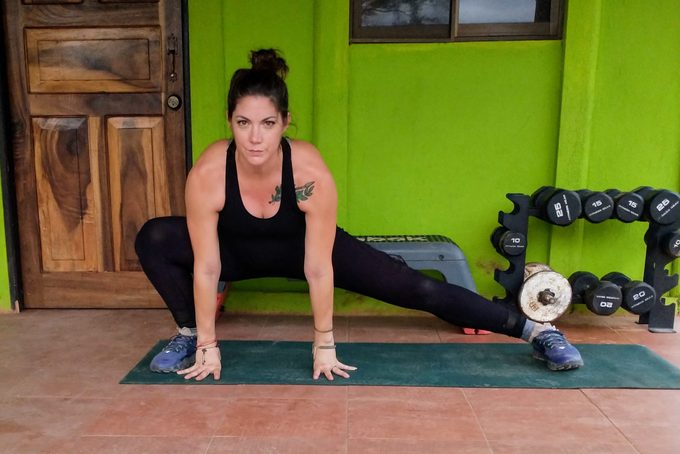
How to do it
Stand tall, your feet roughly hip-distance apart. Engage your core and check your posture. Take a wide step out to the right with your right foot, angling your toes outward and aligning your knee to point in the same direction as your toes.
Keep your left leg completely straight, your foot planted. Press your hips back and begin bending your left knee (aligning it with your toes) as you lower your hips toward the ground.
It’s important that you keep your chest lifted as your hips press backward—you don’t want your chest or head “collapsing” toward the floor.
Reach your hands to touch the floor, lightly supporting your body as you find the point of stretch in your left groin.
You can “heel-toe walk” your right foot out farther to the side to deepen the stretch if it’s comfortable.
When you find your endpoint, hold the position for 30 to 60 seconds before resetting and performing the stretch to the left side.
Complete two to three sets per side.
(Monster walks can help strengthen your abductors.)
Seated wide-legged forward fold
The seated wide-legged forward fold is another stretch that helps isolate your adductors, while you’ll also likely feel a light stretch through your hamstrings, glutes, and even your low back.
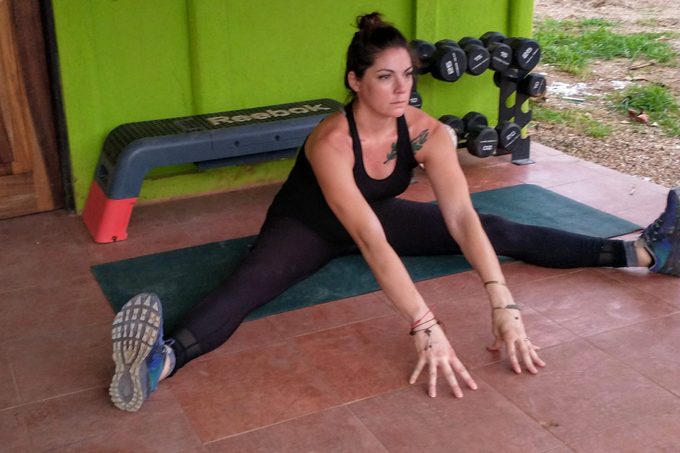
How to do it
Sit tall on a mat with good posture, your legs extended in front of you. Engage your core and pull your shoulders back.
Start moving both of your legs away from your midline, spreading them away from each other until you feel a stretch through your groin.
If your adductors are tight, you may need to simply hold the stretch here where you feel comfortable, without moving your torso.
If you feel you have room to deepen the stretch, place your fingertips lightly on the ground between your legs and begin “walking” your hands forward.
As you move your hands forward, begin tipping at the hip, allowing your chest to lean over your hips. It’s very important that you keep your torso upright, your core engaged, and your shoulders back—you don’t want to round or “collapse” your torso over your legs.
When you’ve reached a point of comfortable stretch, stop and hold the position for 30 to 60 seconds.
Release the stretch, then repeat two more times.
(Don’t overlook stretching your hip flexors, too.)
Yogi squat
In yoga, the yogi squat, or malasana, is considered a “hip opener,” designed to create space through the hips and alleviate pain, tightness, and soreness associated with the hips, glutes, and low back.
In addition to stretching the adductors, you’ll also feel a stretch at your ankles, glutes, and low back.
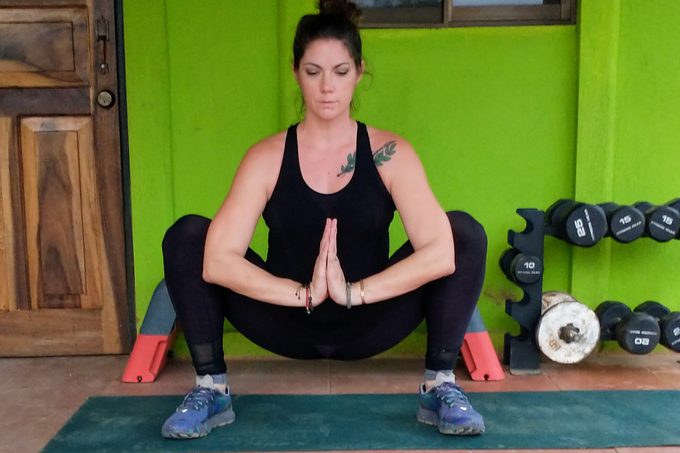
How to do it
Stand tall, your feet slightly wider than hip-distance apart, your toes angled outward at roughly 45-degrees. Check your posture and engage your core.
Take a breath in and begin pressing your hips back as you bend your knees, lowering into a squat.
It’s important to keep your torso, chest, and shoulders upright as you squat.
When you reach the bottom-most point of your squat (the goal is to get your hips lower than your knees), hold the position and place your elbows on the inside of each thigh.
Bring your palms together in a “prayer” position at your chest, and use your elbows to press your thighs outward until you feel a stretch through your groin.
Hold the position for 30 to 60 seconds before returning to a standing position.
Repeat the stretch two more times.
(When you’re dealing with hip pain, try these stretches.)
Butterfly
You probably remember the butterfly stretch from elementary school. And to be clear, the basics remain the same.
This stretch is excellent for easing tension in the groin. That said, it’s important to avoid “bouncing” your legs up and down as you stretch.
Simply hold the position in place when you find your comfortable endpoint.
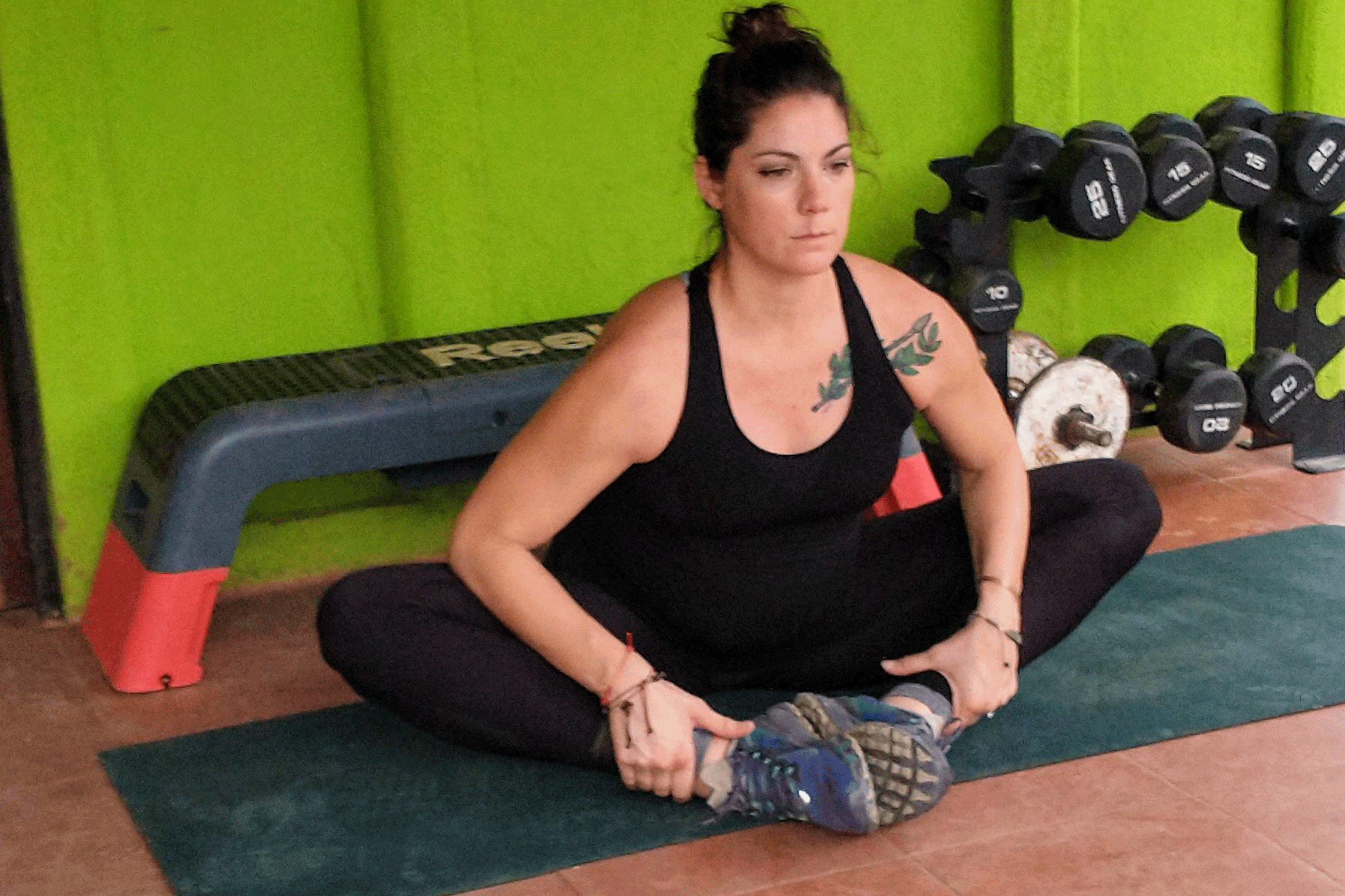
How to do it
Sit on a mat on the floor, your knees bent, feet flat on the ground in front of you. Draw your heels closer to your hips, then open your knees outward, lowering them toward the ground.
Place the bottom of your feet together. Check your posture—your core should be engaged and your torso seated tall with your shoulders back and chest lifted.
When you feel a stretch through your groin, like you can’t open your knees further, stop the stretch.
If you can, pull your heels a little closer to your hips and use your elbows to place slight pressure on the inside of your knees to hold or deepen the stretch.
You can tip your torso slightly forward from the hips (without losing your good posture) to offer a little more assistance.
Maintain the position for 30 to 60 seconds before releasing the stretch.
Repeat two more times.
Next, here’s what you need to know about ballistic stretching and whether it’s safe.






















